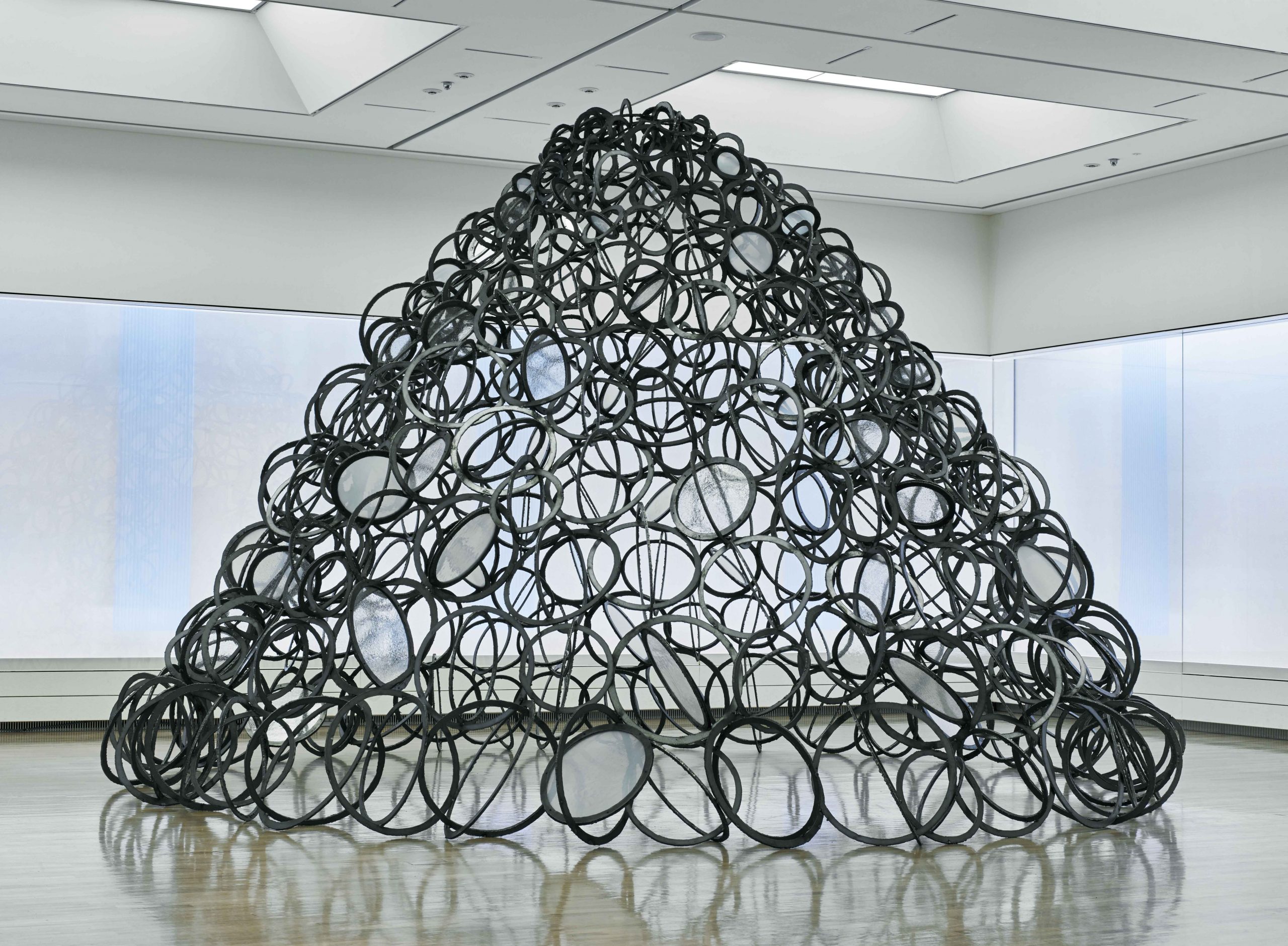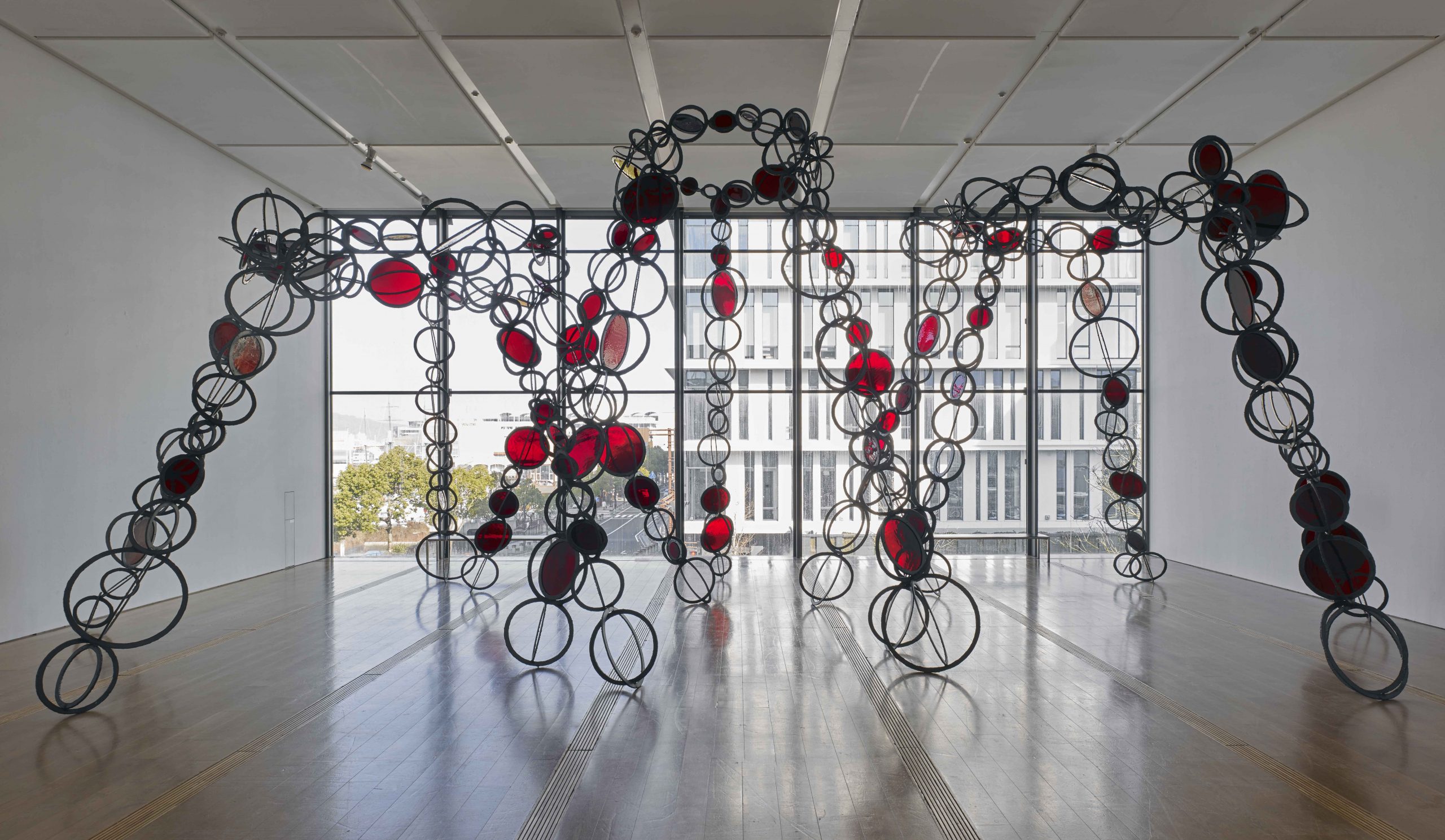青木野枝 AOKI Noe

《霧と鉄と山 ‒Ⅰ》 2019年 鉄、ガラス、波板 H450, φ600 cm 府中市美術館での展示風景 撮影:山本 糾
kiri to tetsu to yama Ⅰ(fog, iron, and mountains ‒Ⅰ) 2019 iron, glass, plastic corrugated sheet H450, φ600 cm Installation view at Fuchu Art Museum Photo by YAMAMOTO Tadasu Courtesy of ANOMALY
青木野枝
AOKI Noe
1958年、東京都生まれ。埼玉県に在住、活動。
「霧と鉄と山と」
神山亮子
青木野枝はこれまでも置く場との対話によって、その彫刻を決定してきた。自身が見たい彫刻、見たい世界が、その場にどのように実在しうるかについて探ってきた。ニュートラルな空間を持つ美術館や画廊であれば、特に建築的要素へと意識が向かう。府中市美術館では、ガラスケースの手前の仮設壁をすべて取り払い、そこから発する光の中に彫刻を置いた。床に重い身を沈めつつ上へ上と伸びゆくかたちは、展示室に潜む幾多の水平線と垂直線と共鳴する。余分な要素をそぎ落として現れた展示室の裸の空間のボリュームに青木の彫刻が繊細に応答して、緊張感が心地よい。
野外となれば、青木の関心は周囲の環境や自然、土地の歴史や人々のくらしへと向けられる。2019年の九州の2つの美術館 *1)での場との向き合い方は、野外展示でとる立場に近しいのかもしれない。ただし、新しい素材がこれほど続けて採用されたことはなかったし、その素材の意味づけが語られることもなかった。鉄を用いてきた期間の長さに比べると、この1年の鉄以外の素材の使用にはやはり驚かされる。2012年以降の石膏も加えてよいだろう。何が青木を動かしたのかについては、もう少し時を経ないとわからないかもしれない。ひとつ指摘できるのは、彫刻として現れた姿は、どれも面を持ち、かたまりであることだ。かたまりであることは、削ぎ落とした遠心的な彫刻をつくってきた青木が、新たな膨らみをかかえることを肯定するサインとも理解できないだろうか。その膨らみがすなわち、今回メインモティーフとなった「山」に象徴されている。
山は、人間の思惑を超えて存在するものだ。私たちは山を眺め、周りをめぐり、間を抜けることができる。実際に手をかけ足を蹴って登れはしないが、その行為を想像することは可能だ。青木野枝の彫刻は、そうした「山」としてあることによって、私たちが私たちの生や死や過去の記憶などと自由に結びつけることを、あたたかく受け入れてくれる。
青木野枝の彫刻は今も動いている。その自由さに憧れる。
*1)「青木野枝 ふりそそぐものたち」長崎県美術館 2019年2月9日〜3月24日 「青木野枝 霧と山」鹿児島県霧島アートの森 2019年7月26日〜9月23日
「青木野枝 霧と鉄と山と 記録集」(2020年 府中市美術館)所収のテキストより抜粋。展覧会「青木野枝 霧と鉄と山と」府中市美術館 2019年12月14日~2020年3月1日
Born in Tokyo, Japan, 1960. Lives and works in Saitama.
Fog, Iron, and Mountains
KAMIYAMA Ryoko
Aoki Noe has heretofore decided on her sculptures through conversations with the location in which they are to be placed. She has tried to find out how the sculpture or world she wants to see could actually exist in that location. In the case of art museums or art galleries, which possess neutral spaces, her attention is turned particularly towards the architectural elements. In Fuchu, the temporary partitions in front of the showcase walls were removed and the sculptures were placed amidst the light emitted from the showcase walls. Although the heavy bodies of the forms sink into the floor, they stretch up and up and resonate with the numerous horizontal and vertical lines lurking in the gallery. Aoki’s sculptures subtly respond to the volume of the bare gallery space where excessive elements have been pruned, producing a pleasant feeling of tension.
When the work is placed outdoors, Aoki’s attention is directed towards the surrounding environment and nature, the local history, and the lifestyle of the people living there. The way she confronted the sites in the museums in Kyushu in 2019 *1) may have been close to the standpoint she takes when working on open-air displays. However, she has never employed new materials so continuously in the past and she has never explained what significance she attaches to each material. Compared to the length of time she has employed iron, her use of materials other than iron in the past year is, after all, astonishing. Plaster, which she has been employing from 2012, could also be added. Perhaps we will not be able to tell what it was that stirred the artist until a little more time goes by.
One point that can be made is that the forms which emerge as sculptures all have planes and are masses. Couldn’t the fact that they are masses be interpreted as a sign that Aoki, who has been producing pruned, centrifugal sculptures, agrees to take on a new bulge? That bulge is symbolized as a “mountain,” which is the main motif in the current exhibition. These mountains also allow us to connect Aoki Noe’s sculpture freely to our life, death, and memories of the past.
Aoki Noe’s sculptures continue to move even now. I cannot help admiring such freedom.
*1) Nagasaki Prefectural Art Museum, Noe Aoki: All That Floats Down, February 9 to March 24, 2019. Kirishima Open-Air Museum, Aoki Noe: Fog and Mountains, July 26 to September 23, 2019.
This text is excerpted from a document book of the exhibition Noe Aoki ; Fog, Iron, and Mountains, which was held by Fuchu Art Museum from December 14, 2019 to March 1, 2020. (Translated by OGAWA Kikuko )
更新された最新の情報は、作家のウェブサイト等をご覧ください。
Please refer to the artist’s website for new updates.

《曇天Ⅰ, 曇天Ⅱ》 2019年 石膏、麻布、新聞紙、鉄 Ⅰ:H270, 300×270 cm Ⅱ:H270, 344×280 cm 府中市美術館での展示風景 撮影:山本 糾
donten Ⅰ(cloud sky Ⅰ), donten Ⅱ(cloud sky Ⅱ) 2019 plaster, hemp, cloth, newspaper, iron Ⅰ:H270, 300×270 cm Ⅱ:H270, 344×280 cm Installation view at Fuchu Art Museum Photo by YAMAMOTO Tadasu Courtesy of ANOMALY

《霧と鉄と山 ‒Ⅱ》 2019年 鉄、ガラス H470, 670×260 cm 府中市美術館での展示風景 撮影:山本 糾
kiri to tetsu to yama Ⅱ(fog, iron, and mountains ‒Ⅱ) 2019 iron and glass H470, 670×260 cm Installation view at Fuchu Art Museum Photo by YAMAMOTO Tadasu Courtesy of ANOMALY

《ふりそそぐものたち/長崎》 2019年 鉄、ガラス 580×1,370×1,500 cm 長崎県美術館での展示風景 撮影:山本 糾
furisosogumonotachi/ nagasaki(all that floats down / nagasaki) 2019 iron and glass 580×1,370×1,500 cm Installation view at Nagasaki Prefectural Art Museum Photo by YAMAMOTO Tadasu Courtesy of ANOMALY

《立山/長崎》 2019年 鉄、石鹸 173×54×51 cm(12pieces) 長崎県美術館での展示風景 撮影:山本 糾
tateyama/nagasaki 2019 iron, soap 173×54×51 cm(12pieces) Installation view at Nagasaki Prefectural Art Museum Photo by YAMAMOTO Tadasu Courtesy of ANOMALY

